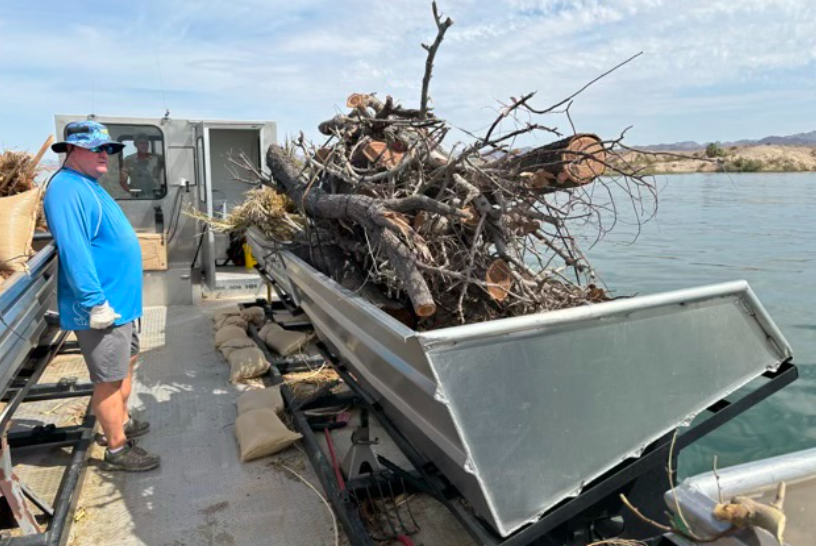Lake Havasu Fish Report for 8-30-2024
Lake Havasu Fisheries Improvement Program ramps up again
Lake Havasu - Havasu City, AZ

by Arizona Game & Fish Department
8-30-2024
Website
The Lake Havasu Fisheries Improvement Program (LHFIP) was revitalized this year and has been making habitat improvements that can help congregate fish and improve angler catch rates.
The program began in 1993 with the original goal of installing 875 acres of artificial habitat, building six shore access fishing facilities, and augmenting the 30,000 razorback suckers and 30,000 bonytail chub into Lake Havasu. These goals were all accomplished in the early 2000s and new goals of adding 800 brush bundles and maintaining the current 875 acres of artificial habitat and six shore fishing facilities every year were set in 2005.
This program was very successful for many years until COVID-19 halted operations in 2020. This January, the program was revitalized. Starting with 342 donated Christmas trees, the LHFIP began adding brush bundles to the lake again. So far this year, the partnership has added over 600 brush bundles of Christmas trees, donated landscaping trimmings, and large woody debris to the lake. This organic matter adds valuable nutrients and habitat to the bottom of the lake that is otherwise a flat substrate. Providing this structure can congregate fish, providing areas for anglers to target and enhancing catch rates.
Getting this habitat program back up and running would not be possible without all the hard work from the Bureau of Land Management and the other partners in the LHFIP (Arizona State Parks and Trails, Arizona Game and Fish, Anglers United, Bureau of Reclamation, California Department of Fish and Wildlife, Go Lake Havasu, Havasu Riviera Marina, Lake Havasu Dive Association, Lake Havasu Marine Association, U.S. Fish and Wildlife Service, and US Geological Survey).
More Reports
8-22-2024
When it comes to dove hunting in Arizona, one thing is pretty much indisputable: There’s never a bad season opener. All signs...... Read More
Arizona Game & Fish Department Reports
for Wednesday, July 31st, 2024
Kaibab Lake: Still a Few Catches on Kaibab
Cataract Lake: Fish Still Active
City Reservoir: The lake is full
Dogtown Lake: Access to the lake and campground are open!
Santa Fe Lake: Sante Fe Lake Updates
Whitehorse Lake: Lake Open and Fish Active
J. D. Dam Lake: JD Dam is Catch-and-Release Only for Trout
Russel Tank: Water Level Has Dropped
Francis Short Pond: Frances Short Pond Updates
Ashurst Lake: Ashurst Lake Updates
Kinnikinick Lake: FR 82 and 125 to Kinnikinick Lake are open
Bartlett Lake: Reports of Tough Fishing
Lake Pleasant: Fishing is rated as good!
Roosevelt Lake: Fishing is rated as very good
Lower Salt River: Fishing is rated as good!
Oak Creek: Catch-and-release section has expanded
West Clear Creek: Smallmouth bass are unlimited harvest
Wet Beaver Creek : Bass are unlimited harvest
Lake Powell: Awesome Fishing Trips at Lake Powell!
C. C. Cragin Reservoir: Folks have been finding success trolling small lures
Huffer Tank: Huffer Tank is full
Knoll Lake: Knoll Lake Updates
Colorado River - Laughlin: Success on Nevada Side of Colorado River
Lake Mohave: Luck near the basin
Cluff Ranch Ponds: Nice Article About Cluff Pond 3
Colorado River: BOR begins cold water flows to disrupt spawning of nonnative smallmouth bass below Glen Canyon Dam
Lake Havasu: Catching the bass of a lifetime at Lake Havasu
Silver Creek AZ: Silver Creek Hatchery staff and volunteers help renovate the creek

Website Hosting and Design provided by TECK.net